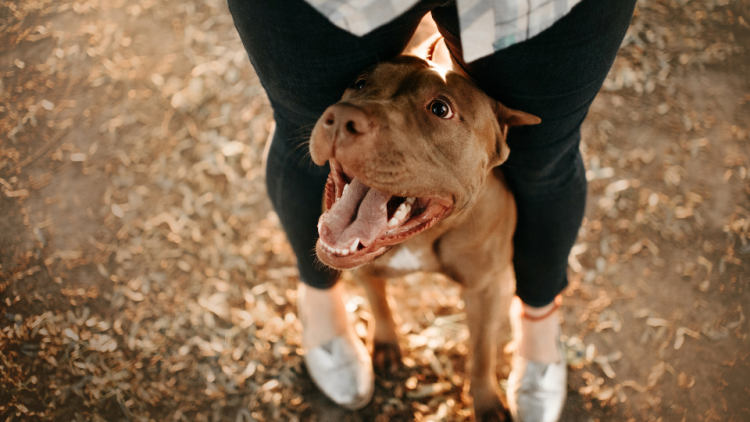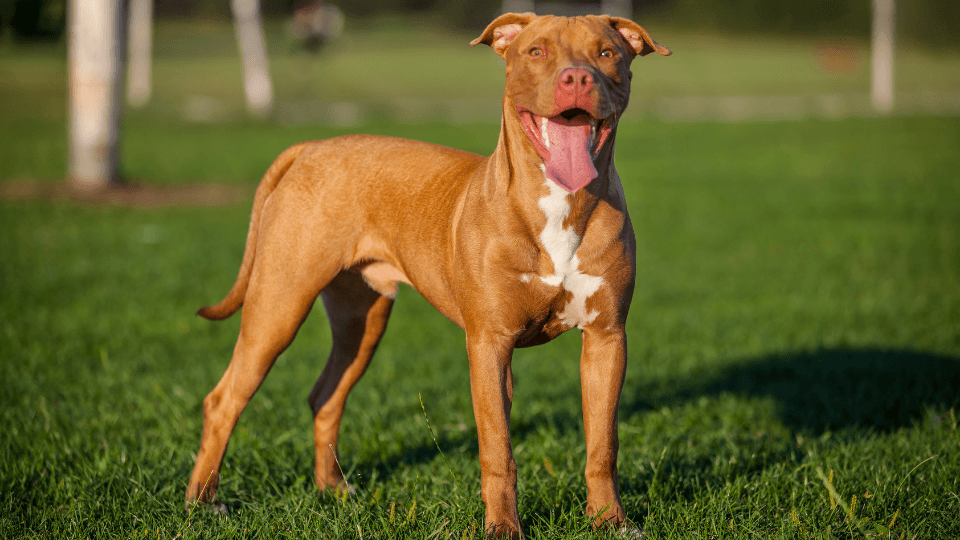American Pit Bull Terriers (APBTs), also known as Pit Bulls or Pitties, are a protective, loyal breed. Many people think that these strong, muscular dogs can be quite aggressive, though this is often an untrue stereotype.
If you've been considering adding a Pit Bull Terrier to your household, or you recently gained a new four-legged family member, it's worth learning more about these breed characteristics.
To help, we've compiled this complete guide to American Pit Bull Terriers. It covers breed traits, care requirements, training tips, and more. After reading our Pit Bull breed overview, you'll know how to be the best pet parent possible to one of these devotional dogs.
Table of Contents
- Pit Bull Terrier characteristics
- Pit Bull Terrier breed history
- Pit Bull care tips
- Common Pit Bull Terrier health issues
- Adopting or buying a Pit Bull dog
- Key Takeaways
Pro Tip: No matter what type of breed you bring home, pet insurance is valuable because it can protect your pal's health and safeguard your finances against expensive veterinary bills down the road. The high cost of dog ownership often catches pet parents off guard, but by enrolling in an insurance policy, you'll always be prepared to provide access to gold-standard vet care should your little one ever get sick or injured.
American Pit Bull Terrier characteristics
Physical appearance
American Pit Bull Terriers are a member of the Bull group of dog breeds. As such, they're built short and stocky, with wide, powerful jaws and small- to medium-sized ears set high on a broad, flat head. Their low-to-the-ground bodies feature a whip-like tail and short, dense fur that comes in a variety of colors. The most common Pit Bull colors include:
- White
- Gray
- Black
- Brown
- Brindle
- Tan
- Fawn
- Red
- Blue
Given their average height of 17 to 21 inches (from the ground to the top of their shoulders), the weight of an American Pit Bull Terrier is relatively heavy for the small bodies, with a healthy range of 55 to 70 pounds.
View the American Pit Bull Terrier Weight Chart
Compared to the Staffordshire Bull Terrier, the American Pitty is taller, heavier, and has a slightly sloping topline (along the ridge of the spine) extending downward from the shoulders toward the rear end.
An American Pit Bull Terrier, officially recognized by the United Kennel Club, is very similar in breed presentation to the American Staffordshire Terrier — the official breed accepted by the American Kennel Club (AKC). The slight differences in apppearance are characterized AKC size guidelines but generally, APBT faces are less round and their muzzles are more elongated, lacking the distinctive, pushed-in nose (as seen in English Bulldogs and [French Bulldogs]((https://www.pawlicy.com/blog/french-bulldog-breed/), for example).

Temperament and personality
"Are Pit Bulls aggressive?" No, not inherently. Contrary to common misconceptions, the American Pit Bull Terrier temperament is gentle and patient. Pit Bulls are not naturally aggressive towards people and usually act great with children — although there are exceptions, as with all dog breeds. Some members of the breed can be unfriendly towards other dogs, especially other Pit Bulls, but early socialization and obedience training can help correct any inappropriate behavior.
In fact, the American Temperament Breed Society (ATTS) found that when tested under the same conditions, Pit Bulls are slightly less likely to show signs of aggression than Golden Retrievers, one of the most popular dog breeds in America (86% pass rate vs. 85.2%, respectively).
Other breeds that are more likely to show signs of aggression than Pit Bulls include:
The belief that all Pits are dangerous is unfounded. In reality, the American Pit Bull Terrier temperament is friendly and playful. True to their Terrier nature, they often have charming personalities that are full of mischievous energy. While these fearless dogs carry themselves with impressive confidence, they also have a strong desire to please people and are quick to greet their humans with an energetically wagging tail at the door.
Their unfortunate and incorrect stereotype was largely formed by the use of Pit Bulls in illegal and unethical dogfighting where these dogs had to be specifically trained to be aggressive, contradictory to their inherent friendly and gentle nature.
Average lifespan
How long do Pit Bulls live? Most American Pit Bulls live for about 12 years, though the average life expectancy ranges from 10 to 14 years, depending on several factors. Keeping your Pitty at a healthy weight and taking them to wellness checks at the vet every six to twelve months can play a big part in helping them achieve a long, fulfilling life.
Bull Terrier breed history
The American Pit Bull Terrier originated from a long line of Terrier and Bull breeds created in England, Ireland, and Scotland during the early 19th century. Terriers were initially bred to kill vermin, hunt small game, and participate in dogfighting. Bulldogs were also bred for pit fighting with other dogs, as well as bull- and bear-baiting.
They cross-bred these two groups hoping to achieve the gameness of a Terrier and athleticism of a Bulldog. The resulting creation was the 'ideal competitor' in these horrifically bloody sports: a dog that refused to give up, no matter how excruciating the pain, with an unabashed love for humans who put them in the pit, then pulled them from the same.
Following the ban of dogfighting in Europe and the increase in Irish immigration during the mid 19th century, many of these original "bull and terrier" mixes were brought to the US. They evolved from their ancestors across the Atlantic as owners implemented selective breeding practices to enlarge the pit bull's weight, head, and jaws for the unfortunate use of fighting.
However, the dogs' talent for herding livestock, warding off vermin, and devotedly guarding the home did not go unnoticed by American farmers. As they grew in popularity on a new frontier, so did their owners' desire for the recognition of a legitimate breed, but the AKC wanted nothing to do with the bloody lineage. After years of debate and anti-dog fighting legislation, the AKC eventually recognized the breed under a new name in 1972: the American Staffordshire Terrier, or AmStaff.
This title forever separates them from the gruesome pit while still paying homage to their ancestors, the Staffordshire Bull Terrier (knowns as Staffords or Staffies). Some non-AKC registries, like the UKC, include both AmStaffs and APBTs; today, "pit bull" is generally used as a catch-all term for these variations.
Pit Bull care tips
Training and exercise
Pit Bull Terriers can be somewhat stubborn, which is why they need obedience training from an early age. In general, they respond well to commands and aim to please, sometimes to the point of over-exhaustion. Owners should be especially careful with training and exercise during hot weather when dogs are at increased risk of heat stroke and dehydration.
Pit Bull dogs are quite active and playful, so they need regular exercise (about an hour of walking or playing a day) to be happy and healthy, both mentally and physically. Most dogs in this breed enjoy chasing balls, true to their Terrier nature, and playing tug-of-war.
Due to their unique body shape, they may not be the best swimmer, so be sure to always supervise your pet Pit Bull near the pool or at the beach and consider purchasing a life jacket for your pup if they seem to enjoy jumping in the water with your family or when left unattended.

Grooming
As a short-haired breed with no undercoat, the Pit Bull requires minimal grooming — brushing once a week should be enough to prevent excess shedding and matting.
Owners should pay special attention to their ears and check them regularly for earwax buildup, debris, and dirt. Their nails should also be trimmed on a consistent basis (about once or twice a month) to prevent foot injuries.
Dental hygiene is very important for Pit Bull Terriers. Ideally, their teeth should be brushed every day to prevent tooth decay, gingivitis, and gum disease. Bad breath is also quite common with these dogs and will only get worse over time if the underlying dental disease is not treated.
Diet and nutrition
In general, Pit Bulls need about 1.5 - 2.5 cups of dry dog food per day, which should be divided into two meals. This recommendation is an estimate and the exact amount of food your Pittie needs will vary based on their size, age, and activity level. Your veterinarian should always help determine the appropriate diet, feeding amount, and ideal weight for your dog.
Owners should also make sure that their dog always has enough clean, fresh water for drinking. Usually, for every pound of body weight, Pit Bulls should drink about 0.5 - 1 oz of water per day, but this amount can increase during hot days or when the dog is very active.
Your dog's nutrition needs will change as they age so make sure to work together with your veterinarian to create an individual diet plan for your pet.
Living with Pit Bull Terriers
True their Terrier nature, most Pit Bulls are always up for playing and living with them is like a big adventure. Considering the fact that they require vigorous exercise on a daily basis, they are best suited for people with active lifestyles.
Although Pit Bulls are considered tough, they should be shielded from the elements and never be left out for too long when the weather is too cold or too hot for dogs.
Because they may be unfriendly towards dogs they’ve never met, Pit Bulls should be kept on a leash when walking or hiking in public and, like all dogs, they should be supervised when with children.
Common Pit Bull health issues
Compared to other dog breeds, American Pit Bull Terriers are generally healthy. However, they are predisposed to certain health issues, such as elbow and hip dysplasia, kneecap dislocation, hypothyroidism, degenerative myelopathy, and in rare cases, aortic stenosis.
They can also suffer from ear infections, allergies, and skin disorders like mange due to their short coat. Pets with itchy skin conditions and allergies require lifelong management. Your veterinarian may recommend dietary adjustments or medicine like Benadryl for dogs.
Pro Tip: Consider enrolling in Pit Bull pet insurance while your dog is in good health. That way, if they develop one of these conditions due to accidental injury or hereditary illness, you can get reimbursed for a portion of vet costs paid toward covered treatments.
Adopting or buying a Pit Bull Terrier
Pit Bull Terriers and Pit Bull mixes can be found in just about every shelter in the US. There are also several rescue groups dedicated to finding forever homes for these dogs, such as Pit Bull Project and Pit Bull Rescue Central.
If you're interested in similar dog breeds, be sure to also check American Staffordshire Terriers, Staffordshire Bull Terriers, and Boxers.
Key Takeaways
- The American Pit Bull Terrier (APBT) is a loyal, playful companion dog. Contrary to popular belief, this powerfully muscular breed is less aggressive than other popular dog breeds and tends to only show signs of aggression to other dogs, not humans.
- However, owners should be aware that the breed has a history of dogfighting and a strong prey drive, so Pit Bull Terriers should be carefully introduced and supervised with children and other animals.
- Pitties have' short coats that don't require too much grooming. Instead, your pet will thrive with a regular brush, bath, and nail trim.
- Pit Bull Terriers are generally healthy but like all dog breeds, they're predisposed to certain health issues like hip dysplasia, hypothyroidism, aortic stenosis, and skin allergies.
- Owners should work with their vet to develop preventive care and a nutritional plan for their Pit Bull Terrier. Proper diet and early detection of health conditions can go a long way in helping your pet have a healthy and happy life.
